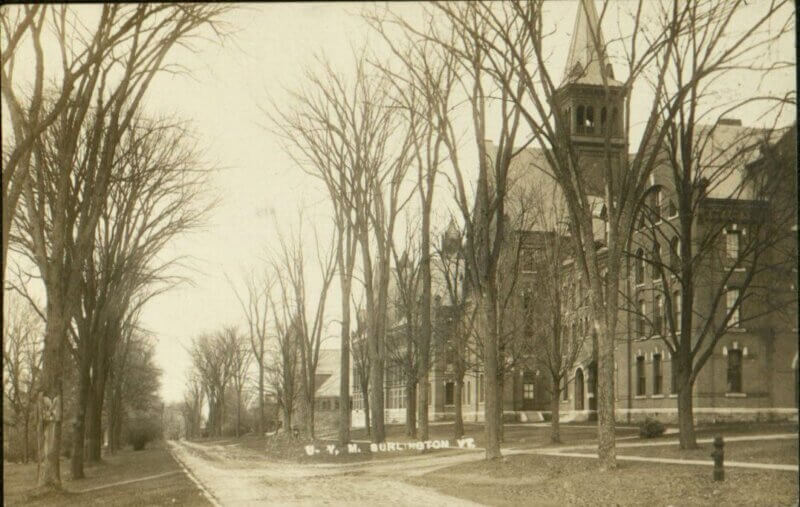Ode to American liberty elm
When I was 6, I stood with my mother and grandmother as workers sawed down elm tree after elm tree after elm tree, the entire length of Wakeman Road.
Dutch elm disease had come to town. Summer sun now bleached what had been shady lanes and streets across America, like ours, transformed into barren landscapes. This fungal disease spread by bark beetles killed virtually every elm in the country, an estimated 100 million trees.
Fast forward too many decades to mention. A similar drama unfolded in our yard a few weeks ago. Same heartache, same sinking feeling. Another elm bites the dust. But this elm was supposed to be different.

American elms that were dying from Dutch elm disease line the street in front of Old Mill building and Billings Library at the University of Vermont.
Our tree was an American liberty elm, guaranteed to be resistant to Dutch elm disease. We planted it more than 30 years ago. Our sapling thrived, stretching over the roof of our house, until last August when half of its leaves abruptly yellowed and fell to earth. By February, piles of bark heaped around the half-naked trunk. Arborists confirmed that the tree was dying, likely of Dutch elm disease.
American liberty elms were developed by the New Hampshire-based Elm Research Institute. The non-profit, founded in 1967, is dedicated to restoration of the American elm. It produces and distributes disease-resistant elms, which it also guarantees. I will be sending a sample of bark and pulpwood to be tested. If our tree succumbed to the fungus, it will be replaced without cost — other than the drive to Walpole to collect a new sapling.
The American liberty elm recalls important Colonial-era history. The first public shade tree, an elm, was planted in Boston in 1646. The Sons of Liberty gathered beneath its branches to organize opposition to the British crown. This Liberty Tree symbolized resistance and inspired settlers to plant elm trees throughout New England and to the west as they migrated. Elms became a symbol of freedom. In 1775, the Liberty Tree was axed by British Loyalists but by then elms grew in nearly every town across the country. Which is why Dutch Elm disease, when it arrived in the 1930s, altered the landscape of America, turning leafy Elm Streets across the land into bleak, treeless deserts.
Through genetic research and selective breeding of descendants of trees that had not succumbed to Dutch elm, the Elm Research Institute developed disease-resistant American elms. The trees were injected with the fungus to confirm resistance. Several other Dutch elm disease-resistant cultivars are on the market, many developed by the U.S. Department of Agriculture, including trees cross-bred with Chinese elms. Part of the majesty and beauty of the American elm is its vase shape and Chinese elms do not have this classic shape. The Liberty elm does.
The elm is not the only tree that has marched toward the edge of extinction. In the decades before World War II, a different fungus killed millions of American chestnuts. The American Chestnut Foundation has been cross-breeding resistant American chestnut trees for decades.
Ash trees are another species now disappearing from our landscape, killed by the emerald ash borer. We can hope that enough specimens survive so that resistant trees can be cultured and bred to replace those lost, estimated to make up 5 percent of Vermont’s forested landscape.
Enjoy your trees while you can.

